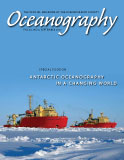Full Text
He never looked back. Literally and figuratively. I remember walking with the Admiral across Washington, DC, or through an airport, never seeing him look to where he’d been. I asked him why he did that. His response: “You should always move with conviction, and with the support of a good team … If you are going the wrong way, that team should step in front and redirect you.”
It was a concept of conduct that served him well, but more importantly, it served us in the oceanographic community superbly. Without the conviction of Admiral James D. Watkins, we would not have a National Ocean Policy, a National Ocean Partnership Program, or a National Ocean Sciences Bowl, arguably three of the most influential actions our community has seen in decades.
The US oceanographic community has a rich history of leadership: Matthew Fontaine Maury, Harald Sverdrup, Senator Fritz Hollings, John Knauss, just to name a few. The Admiral was our most significant modern-day member of that elite group, and for me he was a mentor. His entry into our relatively small community came as a surprise to many (myself included), after he served in a range of highly influential positions in government. When the Board of Governors of the Joint Oceanographic Institutions hired him, they had a tiger by the tail. He came on the scene in 1993, with innovative ideas of what the oceanographic community needed. His evident passion for the ocean was deeply rooted in his years as a Navy submariner, yet he struck a resonant chord with every faction of the community: scientists, conservationists, policy types, and students. He was masterful in his ability to focus this disparate set of interests into common causes. I think his only frustration was that the same command and control structure that worked so well aboard a naval vessel wasn’t executed quite as cleanly in the academic community. He once told me, “When I give the order, ‘Right full rudder,’ I expect the wake to change!”
Admiral Jim Watkins was also a man who set the bar high. His expectations of himself and all those around him were always just slightly beyond reach. He was fond of giving people a grade of “A minus” for an outstanding effort. When I was Executive Director, Consortium for Oceanographic Research and Education, he actually gave me an “A” once (I can’t recall what I did to deserve it), and asked him why I got such a high grade … at which point he said, “Okay, then A minus.” He had the powerful effect of getting extraordinary effort from people. When I introduced myself to then-Chief of Naval Operations ADM Mike Boorda as someone who worked for Admiral Watkins, his response was, “We all do.”
So, to “the Admiral” we say, of course, “fair winds and following seas,” and know that we will follow his wake for years to come.
— Richard W. Spinrad, Vice President for Research, Oregon State University

